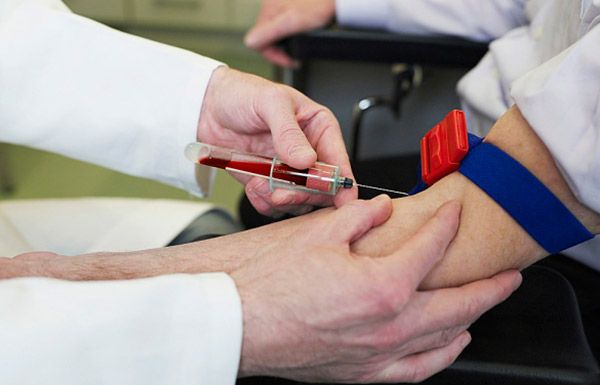Medical expert of the article
New publications
Microscopic polyangiitis
Last reviewed: 04.07.2025

All iLive content is medically reviewed or fact checked to ensure as much factual accuracy as possible.
We have strict sourcing guidelines and only link to reputable media sites, academic research institutions and, whenever possible, medically peer reviewed studies. Note that the numbers in parentheses ([1], [2], etc.) are clickable links to these studies.
If you feel that any of our content is inaccurate, out-of-date, or otherwise questionable, please select it and press Ctrl + Enter.

Microscopic polyangiitis is a necrotizing vasculitis with minimal or no immune deposits, affecting small vessels (arterioles, capillaries, venules), less often medium-caliber arteries, with necrotizing glomerulonephritis and pulmonary capillaritis predominating in the clinical picture.
Epidemiology
Currently, microscopic polyangiitis is registered almost 10 times more often than nodular polyarteritis. The incidence of microscopic polyangiitis is 0.36 per 100,000 population. Microscopic polyangiitis most often develops at the age of 50-60 years, with almost equal frequency in men and women.
Causes microscopic polyangiitis
The disease microscopic polyangiitis was described by J. Davson et al. in 1948 as a separate variant of nodular polyarteritis, in which arterial hypertension is rare, but there is focal necrotizing glomerulonephritis, indicating damage to small vessels. The form of kidney damage (segmental necrotizing pauci-immune glomerulonephritis), combining microscopic polyangiitis, Wegener's granulomatosis and rapidly progressive glomerulonephritis without extrarenal signs of vasculitis, confirms the legitimacy of isolating microscopic polyangiitis as an independent nosological form, different from nodular polyarteritis. The detection of ANCA in the blood of patients with microscopic polyangiitis made it possible to classify this form of systemic vasculitis into the group of ANCA-associated vasculitis, and glomerulonephritis in this form of vasculitis into low-immune rapidly progressive glomerulonephritis associated with the presence of ANCA (type III no R. Glassock, 1997).
The basic concepts of the role of ANCA in the pathogenesis of systemic vasculitis were outlined in the description of Wegener's granulomatosis. Unlike the latter, pANCA against myeloperoxidase is detected in the blood of most patients with microscopic polyangiitis.
Pathogenesis
A distinctive feature of microscopic polyangiitis is segmental necrotizing vasculitis of small vessels without signs of granulomatous inflammation. In addition to vasculitis of the microcirculatory bed, necrotizing arteritis may develop, histologically similar to that in nodular polyarteritis. Small vessels of the kidneys, lungs and skin are most often affected.
- In the skin, the development of dermal leukocytoclastic venulitis is characteristic.
- Necrotizing alveolitis with septal capillaries and massive neutrophilic infiltration develops in the lungs. In the event of death of a patient from pulmonary hemorrhage, pulmonary hemosiderosis is found during autopsy.
- The kidneys show a morphological picture of focal segmental necrotizing glomerulonephritis with crescents, identical to glomerulonephritis in Wegener's granulomatosis. Unlike the latter, kidney damage in microscopic polyangiitis is not characterized by interstitial granulomas and necrotizing vasculitis of the efferent vasa recta and peritubular capillaries.
Symptoms microscopic polyangiitis
Symptoms of microscopic polyangiitis begin with fever, migrating arthralgia and myalgia, hemorrhagic purpura, weight loss. About a third of patients suffer from ulcerative necrotic rhinitis at the onset of the disease. Unlike Wegener's granulomatosis, changes in the upper respiratory tract are reversible, are not accompanied by tissue destruction and therefore do not lead to deformation of the nose.
Biopsy of the nasal mucosa does not reveal granulomas, but only non-specific inflammation. Manifestations of internal organ damage in microscopic polyangiitis and Wegener's granulomatosis are similar.
The prognosis is determined by damage to the lungs and kidneys.
- The lungs are involved in the pathological process in 50% of patients. Clinically, hemoptysis, dyspnea, cough, and chest pain are noted. The most dangerous symptom is pulmonary hemorrhage, which becomes the main cause of death in patients with microscopic polyangiitis in the acute period. X-rays reveal massive infiltrates in both lungs, signs of hemorrhagic alveolitis.
- Kidney damage is found in 90-100% of patients with microscopic polyangiitis. It manifests itself in most cases by symptoms of rapidly progressing glomerulonephritis with increasing renal failure, persistent hematuria and moderate proteinuria, which usually does not reach the nephrotic level. Arterial hypertension is moderate and, unlike Wegener's granulomatosis, does not develop often.
About 20% of patients, as with Wegener's granulomatosis, have severe renal failure at the time of diagnosis and require hemodialysis, which can later be stopped in most of them.
Along with the kidneys and lungs, the gastrointestinal tract and peripheral nervous system are affected by microscopic polyangiitis. The nature of their damage is the same as in Wegener's granulomatosis.
Diagnostics microscopic polyangiitis
In patients with microscopic polyangiitis, an increased ESR, moderate hypochromic anemia, increasing in the case of pulmonary hemorrhage, neutrophilic leukocytosis, and an increase in the concentration of C-reactive protein are detected.

Unlike polyarteritis nodosa, HBV markers are absent in most patients. Almost 80% of patients have ANCA in their blood, primarily to myeloperoxidase (p-ANCA), but 30% have c-ANCA.
What do need to examine?
What tests are needed?
Differential diagnosis
Microscopic polyangiitis is diagnosed based on the clinical picture, morphological and laboratory data. However, almost 20% of patients do not have ANCA in the blood, and kidney biopsy is not always possible. In these cases, the combination of rapidly progressing glomerulonephritis with other symptoms of small vessel vasculitis allows us to suspect necrotizing vasculitis.
Since the treatment of microscopic polyangiitis and Wegener's granulomatosis is the same in the presence of severe visceritis, which determines the prognosis, there is no need for a clear distinction between these forms of systemic vasculitis.
Differential diagnostics of microscopic polyangiitis is also carried out with nodular polyarteritis. In this case, the doctor should be guided by the clinical and laboratory features of both diseases. Nodular polyarteritis is characterized by abdominal pain syndrome and polyneuropathy, severe, sometimes malignant, arterial hypertension, which almost never occurs in patients with microscopic polyangiitis, scanty urinary syndrome, aneurysms or stenosis of blood vessels during angiography, frequent HBV infection. In microscopic polyangiitis, a combination of hemorrhagic alveolitis with rapidly progressive glomerulonephritis, ANCA in the blood serum is most often detected.
In patients with microscopic polyangiitis, renal-pulmonary syndrome requires differential diagnosis with a number of diseases characterized by similar clinical symptoms.
Who to contact?
Treatment microscopic polyangiitis
Treatment of microscopic polyangiitis as one of the forms of ANCA-associated vasculitis consists of a combination of glucocorticoids with cytostatics. The principles and regimens of immunosuppressive treatment are similar to those used to treat Wegener's granulomatosis.
In the treatment of pauci-immune rapidly progressive glomerulonephritis in the context of microscopic polyangiitis, a shorter course of cyclophosphamide may be used to induce remission, followed by a transition to azathioprine therapy as maintenance therapy, although in the presence of hemorrhagic alveolitis combined with rapidly progressive glomerulonephritis, such a therapy regimen is not used. Severe pulmonary vasculitis in the context of microscopic polyangiitis is an indication for repeated courses of plasmapheresis and intravenous immunoglobulin. Another indication for the administration of immunoglobulin is resistance to active immunosuppressive therapy, which is understood as the lack of effect (continued progression of vasculitis) after 6 weeks or more of use of glucocorticoids and cytostatic drugs.
Forecast
The prognosis for microscopic polyangiitis, as well as for Wegener's granulomatosis, is determined by lung and kidney damage. Hemoptysis is a prognostically unfavorable factor in terms of overall patient survival. The level of creatinine in the blood, exceeding 150 μmol/l before treatment, is a risk factor for chronic renal failure. Taking into account the frequency of massive pulmonary hemorrhages, which are the main cause of death in patients with microscopic polyangiitis, even with the combined use of glucocorticoids and cytostatics, the 5-year survival rate is 65%. Along with pulmonary hemorrhages in the acute period, death often occurs from infectious complications.


 [
[